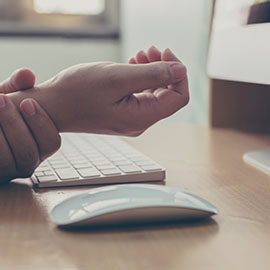Results
Case Studies
Case Study #1
Unexpected New Home Office From COVID-19 Pandemic

An Entrepreneur needed to immediately start working from home due to COVID-19. Using a rolling chair from her office and an antique desk she created a home office and found herself working six to eight hours in her new space. Several weeks later she noticed increased low back, neck, and shoulder pain.
Michelle had the Entrepreneur complete a brief questionnaire prior to their meeting. A virtual ergonomic assessment was completed with the client which included assessment of posture, adjusting home office furniture and current equipment to fit her, education on microbreaks and eye strain, and a customized home exercise program. Michelle was able to provide recommendations including:
- Educational information about posture and microbreaks
- Providing new ergonomic chair options
- Adjusting the keyboard and mouse location to decrease soft tissue stress
- Adjusting monitor height to avoid excess cervical soft tissue stress
- Providing information about lighting to reduce eye strain
- Providing information for standing desk options
- Exercise videos were selected specifically for the client to help address her core strength, flexibility, and reduce cervical and low back pain.
Happy Client
The Entrepreneur purchased a new ergonomic chair and sit-stand desk for her home office. After making some changes to her workstation she immediately began to notice a reduction in her neck and low back pain. The client was able to lead client meetings and work on her computer for a full day with no increased symptoms. She was also happy to increase her recreational activities including yoga and Pilates, which help her manage her stress levels during this extraordinary time.
Case Study #2
Active Programmer with Chronic Back Pain Who Loves the Outdoors

An active Programmer had a history of chronic low back pain. A lover of the outdoors and trail runs over 50 miles per week, he also is a passionate bicyclist. Since chasing after his toddler is part of everyday life, he had concerns about his back. He wanted to learn more about his fixed standing desk and office chair, and how he could work more effectively with decreased low back pain.
The ERGOPowered Response
A virtual ergonomic assessment was arranged. Michelle observed his home office space and was able to see how he used the equipment there. She was able to assess his posture and body positioning while at his computer. Key concerns were identified so that he could make necessary adjustments to his home office setup:
- Education information on posture and importance of correct posture to help manage and reduce lumbar pain
- Adjusting chair to decrease upper trapezius recruitment, increase lumbar support, and decreased lower extremity soft tissue stress
- Recommending chair and desk options to help manage lumbar pain and to provide a more ergonomic setup
- Educating on use of ergonomic keyboard to decreased soft tissue stress to forearms and wrists
- Adjusting laptop height and location to reduce stress to cervical spine and reduce eye strain
- Educational information on lumbar core stability with transitional movements and static and dynamic activities to help manage and reduce lumbar pain.
- Providing customized home exercise program to address hip strength, hip mobility, thoracic mobility, postural strengthening, and lumbar core stability.
Happy Client
The Programmer was thrilled to make valuable changes to his home office which would help to manage and reduce his chronic low back pain. He was also excited to have exercises which would help him reduce and manage his back pain long term, while maintaining an active lifestyle outside of work.
Case Study #3
Active Senior Citizen Wanting to Make a Change to her Computer Setup

An active eighty-five year old was looking for guidance as to how to update her home computer setup. This youthful senior enjoyed using her computer to do research, participate in virtual family gatherings and corresponding through email. Using an antique dining room chair and writing desk as her computer station wasn’t working for her. Slouching in her chair resulted in increased neck and back pain.
In Michelle’s virtual meeting, she listened to the senior’s specific concerns and was able to actively observe how her space was working for her. Michelle identified key concerns and helped make immediate changes, including new equipment recommendations:
- Educating on correct posture and the importance of proper posture and balance
- Recommending a footrest under the desk to avoid increased soft tissue stress to the lower extremities
- Adjusting the position of the monitor to reduce soft tissue stress to the cervical and lumbar regions
- Educating on how the current desk and chair were increasing trunk rotation while at the desk
- Providing personalized exercise videos for strengthening and flexibility to reduce musculoskeletal stress and increase mobility
- Suggesting a variety of ergonomic chair and desk options within the client’s budget
Happy Client
With the education that this active senior received, she was able to immediately find a position which helped to reduce her low back pain while in a seated position. She understood how to correct her posture and why her posture and balance were important to long term health. As a result, she selected a new chair and desk that uniquely suited her needs so that she could work at her computer in a comfortable position for longer periods of time.
Case Study #4
The Permanent Home Office Worker Trying to Adjust Her Sit to Stand Desk

A Consultant had concerns about her home office setup. She was using a sit to stand desk, but was not sure whether it was adjusted correctly. She used both a desktop and laptop computer. She reported tightness to her shoulders, low back pain, prior hip surgery, and a history of carpal tunnel syndrome.
The Consultant completed a brief questionnaire prior to the Ergonomic Assessment. Michelle virtually observed her working in both seated and standing positions. Immediate recommendations were made, including:
- Educational informational on posture, microbreaks, and decreasing strain to eyes
- Educating the Consultant on the appropriate height of her desk in both sitting and standing
- Recommending anti-glare screen covers to limit glare on her monitors
- Adjusting monitor height to decrease stress to cervical, lumbar, and shoulder areas
- Relocating her dual monitor to reflect the amount she used each monitor
- Relocating her laptop for correct eye dominance and adjusting height to reduce soft tissue stress
- Recommending a footrest to decrease lumbar stress
- Recommending ergonomic keyboard to decreased soft tissue stress to the wrist and forearms
- Providing customized exercise videos to help improve strengthening, flexibility, and decreasing soft tissue injury
Happy Client
The client was pleasantly surprised by the immediate changes that she could make to her desk, as well as the educational piece that she received during the ergonomic assessment. The consultant understood not only how to properly adjust her desk but the rationale as to why and when she should adjust her desk height. She was now also equipped with techniques to help prevent future soft tissue injuries to her wrist.
Case Study #5
New hires report pain and inquire about L&I claim

Two new clinic employees reported increased wrist, elbow and neck pain since starting work for the company. Both employees worked at the front desk and spent the majority of their time on computers and using the phone. They approached the Clinic Director to inquire about what steps needed to be taken and at what stage they should file a Labor and Industry Claim. The Clinic Director was genuinely concerned about the employees concerns and discomfort. He sought an outside consultation to avoid any concerns of biased recommendations.
Each employee was interviewed, privately, about their concerns. The employees were observed in their workspace. Recommendations included:
- Adjusting monitor height and placement of monitor to avoid excess stress on neck and shoulders
- Adjusting chair height and depth of seat to unload stress to wrist, neck, and low back
- Educating employee on proper posture
Updated equipment items were suggested at a very nominal cost, which the Clinic Director was willing to accommodate. These included:
- Ergonomic keyboards
- Wrist guards for keyboards
- Headsets for phones
Happy Clients
Individual follow up visits were made with each employee after one month. Both employees were no longer reporting pain or discomfort. They were each able to complete their work tasks with no complaints of physical symptoms. The new employees felt their employer listened and effectively addressed their concerns.
The Clinic Director was thrilled that his new employees were able to work pain-free. Neither employee had to take time off from work for doctor visits for this issue. The Director felt that he was able to address and resolve the employees’ concerns effectively and in a timely manner. He was also happy that no further injury claim needed to be filed, saving the company reporting time and money.
Case Study #6
Increased injuries and demands for expensive standing desks

The Director of Loss and Prevention at a large corporation saw a rise in work-related claims and an increase in requests for stand-up desks. The Director wanted to make sure she was addressing any health concerns of the employees, but also wanted to ensure that the expensive desks were being provided to employees who would benefit from their use.
Michelle met with individual employees and discussed their workstation concerns, observed them working in their current workspace, and made recommendations, including some equipment adjustments, including:
- Providing adjustable desks
- Removing or relocating overhead file cabinets
- Moving the location of floor file cabinets
- Moving workstations to a different locations on the desk
- Providing adjustable monitor and keyboard stands
- Providing ergonomic keyboard/mouse/drawing tablets
- Providing headsets and relocating phone locations
- Adjusting angle, height and/or location of monitors
- Adjusting chairs for improved posture and body mechanics when using the computer
- Adding document holders
- Educational information, including workstation stretches
Happy Clients
By providing ergonomic benefit to the entire staff, the company demonstrated to employees that they are valued. Some employees used this opportunity as a preventative measure to ensure their workstation was set up optimally. Other employees were seeking advice to help minimize and eliminate discomfort while working. All employees received valuable information about body mechanics and posture which could be applied at work and during their home and recreational activities.
The Director was elated since she was able to provide employees with a benefit to help prevent work injuries, provide assistance to employees who were currently experiencing some discomfort, and provide information to employees about general body awareness and mechanics. In addition, she was able to cut down costs on ordering new equipment, as employees were able to learn how to properly use the equipment they currently had and exchange their equipment for other items that were already available within the company.
The company had significantly fewer work injury claims since implementing the program.
Case Study #7
Back-to-work transition for employee after surgery

An employee was preparing for a major surgical procedure. He was very concerned about his recovery and how he would be able to return to work and perform his normal tasks during a standard schedule. His company wanted an outside consultant to help him prepare to transition back to work after his surgery.
Prior to his surgery, Michelle met with the employee in his workspace. We reviewed his post-surgical precautions and made adjustments to his workspace to accommodate the limited mobility he may have upon returning to work. Recommendations included:
- Adjusting monitor height to decrease stress to neck and lower back
- Repositioning recycle bins under his desk to allow for a clear pathway to the hallway
- Repositioning the printer to allow for greater accessibility and decrease trunk rotation
- Providing a floor mat to improve support
- Adjusting the height of his desk to promote improved body mechanics
Once the employee returned to work, Michelle returned for a follow-up visit to make minor adjustments to his workstation.
Happy Clients
The employee was very happy he was able to proceed with surgery knowing that his workspace was already prepared for him when he returned to work. He had greater ease knowing that he had the tools and support to help him return to work safely and to avoid taking additional time off work during his recovery. The employee also felt valued by his employer, who was willing to work closely with him to help him return to work safely.
The employer was pleased to support their employee through his surgery and recovery. They were also excited that they were able to have the valued employee return to work as soon as possible to help support his team and company.
Case Study #8
A competitive runner with increasing knee pain

A competitive runner was reporting pain slowly but inexorably progressing in intensity and frequency. She was preparing for a race which she was determined to complete, since it was a qualifying event for a larger race.
After a thorough evaluation, Michelle determined that a contributing factor to the runner’s knee pain was significant weakness in her gluteal and lumbar core region, resulting in increased loading to her knee while running. Focusing her therapy to include areas beyond the location of her knee pain allowed us to design a program tailored for her needs. This program was able to reduce her immediate symptoms while strengthening areas which were contributing to the origin of her symptoms.
Happy Client
The runner was extremely happy to be able to return to running with no pain, while working on training to avoid future injuries. The runner was not only able to complete her race, but succeeded in qualifying for the Boston Marathon.